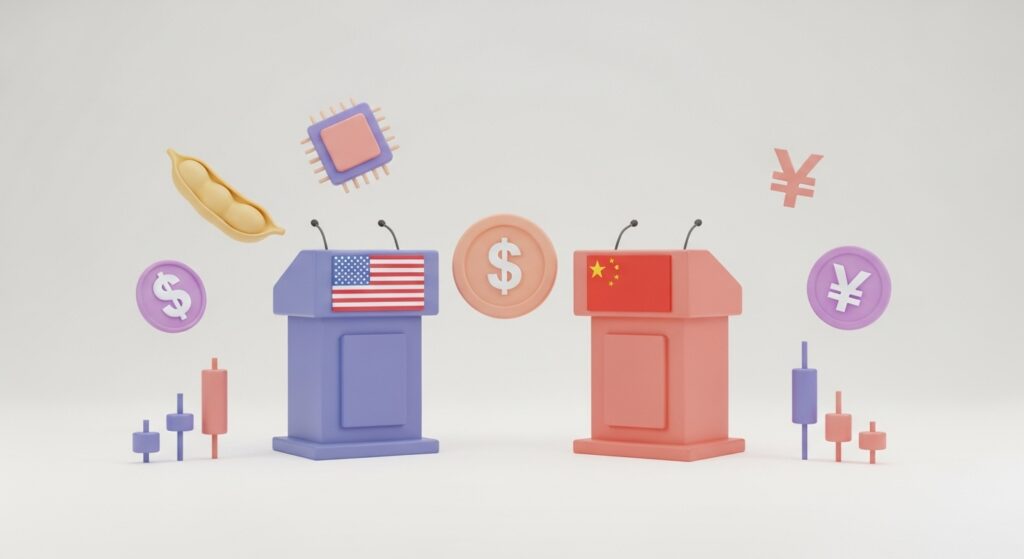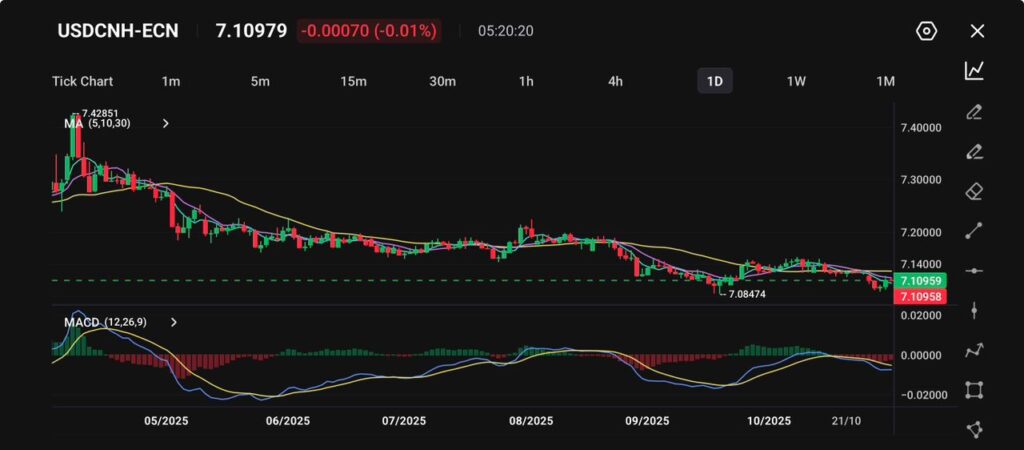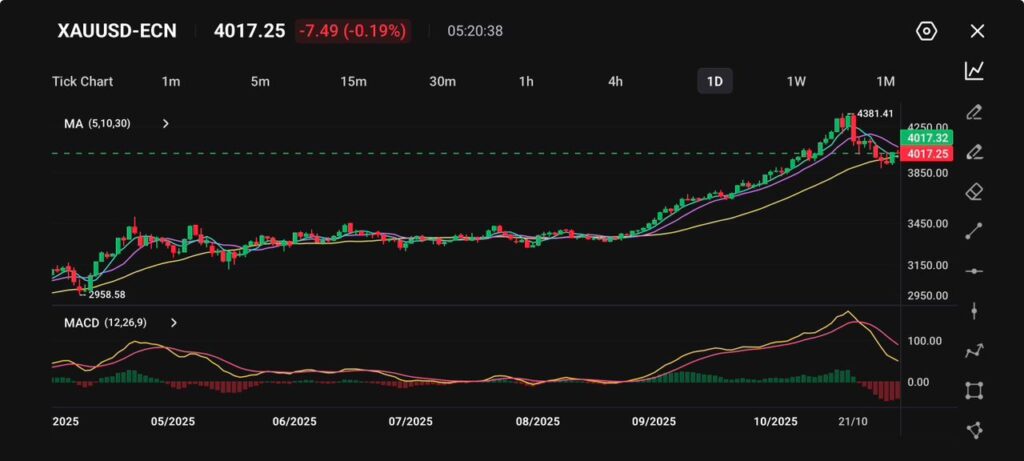
Key Points
- Trump and Xi agree to lower some tariffs and pause rare-earth export controls.
- Fentanyl cooperation adds an unusual but politically charged element to the deal.
- Traders are watching AUD/USD, USD/CNH, gold, and commodity futures for confirmation of renewed risk appetite.
When Donald Trump met Xi Jinping in Busan this week, markets braced for a repeat of the old trade-war theatrics — tariffs, retaliation, and sharp swings in the Yuan.
Instead, the tone was unexpectedly calm, offering a short-term truce that traders hope could cool years of tension between the world’s two largest economies.
The leaders agreed to roll back portions of existing tariffs, with the average levy on Chinese imports expected to drop from roughly 57% to 47%.
In exchange, Beijing pledged to halt new rare-earth export restrictions for one year — a move that relieved pressure on global tech and EV supply chains. Xi also committed to increasing US soybean purchases and tightening controls on the export of fentanyl precursors, a key concern in US domestic policy.
Markets reacted with cautious optimism. The offshore Yuan (USD/CNH) firmed, the Australian dollar nudged higher on improved China sentiment, and Gold remained steady near $4,017 as traders balanced risk-taking with defensive hedging.

The USD/CNH pair held near 7.11, showing muted movement as markets digested the outcome of the recent Trump–Xi meeting, which signalled a cautiously improved tone between Washington and Beijing.
The Yuan strengthened slightly on optimism that renewed dialogue could ease trade and tariff tensions, while the U.S. dollar softened as investors trimmed safe-haven positions.
Technically, the pair remains in a gradual downtrend from its mid-year highs near 7.43, with price action consolidating just above key support at 7.08. The meeting’s emphasis on cooperation on trade stability and fentanyl control measures helped steady sentiment toward Chinese assets, providing the yuan with modest backing even as broader market uncertainty kept volatility low.

Market-wise, optimism around U.S.–China trade cooperation and fentanyl control measures briefly lifted risk appetite, but traders remain cautious ahead of upcoming U.S. jobs data and Fed commentary, which could reshape expectations for early 2026 rate cuts.
Overall, Gold is holding firm within its bullish structure as investors balance easing geopolitical tensions with lingering uncertainty around the global economic outlook.
Yet beneath the headlines, core issues like semiconductor access, Taiwan, and digital trade remain unresolved.
As analyst Richard Haass put it, “It’s a truce, not a treaty.”
Chart Watch
| Instrument | Current Zone | Market Context |
| AUD/USD | 0.6620–0.6750 | Sensitive to Chinese demand and global risk tone. A sustained move above 0.6750 could confirm renewed optimism. |
| USD/CNH | 7.26–7.35 | Holding below 7.30 suggests traders expect short-term stability. A rise back above 7.35 could signal fading confidence in the deal. |
| Gold (XAU/USD) | ~$3,950 | Continues to serve as an insurance hedge amid political uncertainty. A break above $4,000 may mark renewed safe-haven demand. |
| Soybean Futures | $13.40–13.80/bu | Potential upside if China resumes large-scale US imports, but traders await shipment confirmation. |
| Rare Earth Index | 4,600–4,850 | Stabilising after months of supply worries; gains may extend if China maintains export flow. |
Technical Analysis & Insights
Traders should view the Trump–Xi handshake as a temporary easing, not a pivot. The market’s relief rally remains vulnerable to disappointment, particularly if enforcement of the fentanyl agreement stalls or if Washington reintroduces tech sanctions.
For FX traders, China-sensitive currencies like the Australian and New Zealand dollars could see sustained demand if risk sentiment improves, but the USD remains resilient amid global rate divergence.
For Commodities traders, the biggest relief comes from the rare-earth and soybean pledges.
The rare-earthpause reduces short-term supply shocks for chip and EV manufacturers, while renewed soybean purchases could boost farm commodity demand and rural export data.
However, the semiconductor question remains open. The White House confirmed that Nvidia’s high-end Blackwell chips were not part of discussions, leaving tech stocks exposed to further export controls. That omission may limit how far this risk rally can run.
Why This Meeting Matters
This summit illustrates how geopolitics has evolved from trade spreadsheets to strategic bargaining across technology, health, and security. The inclusion of the fentanyl clause shows Washington’s willingness to link tariffs to non-economic outcomes, setting a precedent that could expand to other sectors.
For traders, that means the next “trade war” may not centre on tariffs at all. It may come in the form of export permits, material quotas, or supply chain access; all of which move markets faster than legislation.
Short-term relief may support equities and risk FX, but traders should remain nimble. Market optimism could fade if the truce fails to produce tangible follow-through in the coming weeks.
Analyst View
History rarely repeats exactly, but it often rhymes. The Trump–Xi summit has revived echoes of 2018’s trade drama, yet the stakes are broader and the playing field more complex.
For traders, this isn’t a moment to predict policy; it’s a time to trade reaction, not intention. The art of the deal, in markets as in politics, lies in timing the pivot before the headlines do.
Create your live VT Markets account and start trading now.
Disclaimer
This article reflects the author’s opinion and analysis of current events. It does not represent the official position of VT Markets and should not be taken as financial advice.









